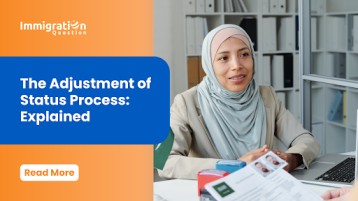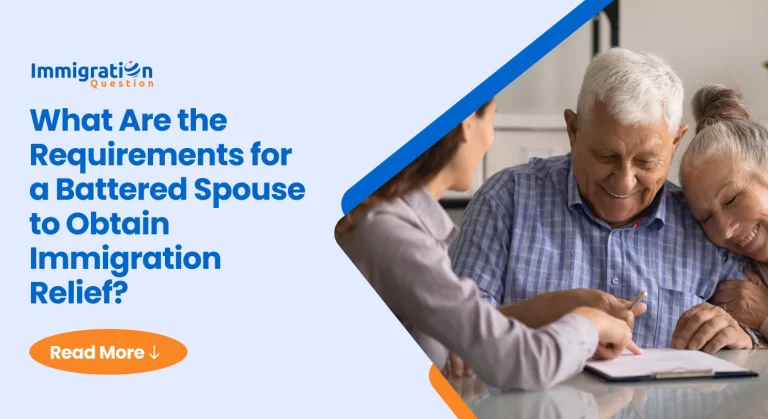Every day, thousands of people leave their home country and head out to other parts of the world. These visits usually require certain important travel documents such as passports and visas. For people who travel on a temporary visa, there is a constant challenge that they must deal with—visa expiry.
The problem with temporary visas is that they expire i.e., they have a duration after which the holder becomes illegal if they remain in that foreign country. In the case of the United States, overstaying your visa will typically get you deported. However, because there are many valid reasons why a person may decide to remain in a foreign country, provisions have been made to cater to this need. One of these is the Adjustment of Status.
Like the name implies, the Adjustment of Status (AOS) process allows you to adjust or change your status (from temporary to permanent) without fear of deportation. It allows specific nonimmigrants to apply for permanent residency while physically present or living in the U.S.
In this guide, you’ll find a step-by-step approach to navigating the AOS process, with a focus on the stages and requirements.
What is Adjustment of Status?
The adjustment of status process allows certain non-U.S. citizens within the United States to apply for lawful permanent residency — also known as a green card — without having to leave the U.S. The process is designed for people who entered the U.S. on temporary visas like the student or work visa and who now wish to become permanent residents.
The alternative to AOS is consular processing, which is when you apply for a green card from outside the United States. When you use consular processing, your green card is processed by your nearest U.S. consulate or embassy, and you have to remain outside the United States until your green card is approved. Both AOS and consular processing have their own timelines, application forms, supporting documents, costs and eligibility requirements. The major eligibility requirements for AOS include:
-
You were lawfully admitted to the United States in an eligible nonimmigrant status
-
Your nonimmigrant status remains valid
-
You have not violated the conditions of your status and you have not committed any crimes that would make you ineligible.
-
You must be physically present in the U.S.
-
You must be eligible for permanent residency through one of the qualifying categories such as family or employment.
How to Get a Green Card Through AOS
If you hope to get a green card through the AOS, follow these steps:
1. Determine Eligibility
You must qualify under one of the following categories:
-
Family-based
-
Employment-based
-
Special immigrant (e.g., religious workers, international broadcasters)
-
Refugee or asylum status
-
Other categories (e.g., Diversity Visa Lottery winners, Cuban Adjustment Act)
2. File Immigrant Petition
Usually, another individual (like a relative or potential employer) files an immigrant petition for you. The petition type depends on your eligibility:
-
Family-based (I-130)
-
Employment based (I-140)
-
Special categories (other specified forms)
3. Verify Visa Availability
Your priority date, which is the date your immigrant petition was filed, must be current. Look at the U.S. Department of State’s monthly Visa Bulletin to know if your priority date is current.
4. File Form I-485
Once you confirm that your priority date is current, fill in and submit Form I-485 (Application to Register Permanent Residence or Adjust Status).
5. Go for Biometrics Appointment
After filing Form I-485, you’ll be required to attend a biometrics appointment. During this appointment, you will provide your fingerprints, photos and signature as required.
6. Attend an Interview
You may have to attend an interview with a USCIS officer who will ask questions about your application and background.
7. Get a Decision
Once your interview (if one is necessary) has taken place and all applicable background checks are concluded, USCIS will decide on whether or not to approve your Form I-485 application; if approved this will result in you receiving your green card
How Much Does Adjustment of Status Cost?
The cost of becoming a lawful permanent resident (a green card holder) by adjusting status in the United States entails numerous fees. As of 2024, some of the main charges include:
1. Form I-485 Fee
-
Fee for Filing Form I-485: $1,140
-
Biometrics fee: $85(for applicants aged 14 – 78)
Total Cost
-
Total Cost (including biometrics fee): $1,225
2. Attorney Fees
Attorney fees can vary considerably, depending on the complexity of your case, and the lawyer’s experience. Typical costs range from $2,000 to $7,000 or more. Some things that may affect cost are:
-
The hourly rate or flat fee charged by an attorney.
-
Complexity of your case (e.g. previous immigration violations, criminal history etc.)
-
Geographic location (attorney fees may be higher in certain areas).
3. Other Possible Fees
Additional fees could also apply depending on your specific situation:
-
Form I-130 (Petition for Alien Relative): $535 (if applying through a family member).
-
Form I-140 (Immigrant Petition for Alien Worker): $700 (if applying through an employer).
-
Form I-693 (Report of Medical Examination and Vaccination Record): It varies because price depends on how much the civil surgeon charges for the medical examination.
-
Form I-765 (Application for Employment Authorization): $410 (if not filed together with Form I-485 or if no fee waiver is available).
-
Form I-131 (Application for Travel Document): $575 (if not filed together with Form I-485 or if no fee waiver is given).
4. Fee Waivers
Fee waivers are sometimes offered for certain forms. In order to qualify, however, there are specific criteria that you must meet which are related to income, financial hardship or entitlement to means-tested benefits. To claim a fee waiver, one must file Form I-912 (Request for Fee Waiver).
Total Estimated Costs
The total expenditure for filing for adjustment of status (after considering all possible expenses) may vary between approximately $3,500 to $10,000.
Note that it is necessary to consult USCIS’s official website or an immigration lawyer for up-to-date information because these fees are subject to change.
Adjustment of Status Timeline
What is the expected timeline for preparing and submitting your application?
The timeline for preparation and submission of an AOS application may vary depending on different circumstances:
1. Initial Preparation (1-3 months)
This involves ensuring you meet the eligibility requirements for AOS; collecting required documents like birth certificates, marriage certificates, passports, visa records, etc.; filing such forms as Form I-485, Form I-130 or I-140, Form I-765, Form I-131; making an appointment to see the USCIS-designated civil surgeon for medical examination; consulting your attorney.
2. Submission of Application (1-2 weeks)
This involves ensuring the forms are complete and signed and that all supporting documents are included. It includes copies of identification documents, immigration status records and the medical examination report.
3. Receipt of Application (2-4 weeks)
Upon submitting each form (e.g., Form I-485, Form I-765, Form I-131), USCIS will mail you receipt notices. This is usually within two to four weeks after they receive your application.
4. Biometrics Appointment (1-2 months after receipt)
You will be notified to attend a biometrics appointment where you will provide fingerprints, photographs and signature. Typically this notice comes within one or two months after your application.
5. Processing Time (6-12 months or longer)
Your application is reviewed by USCIS, background checks are conducted and your forms are processed. USCIS workload and case complexity can significantly influence processing times. In case additional information or documentation is needed, USCIS will send an RFE. Responding to an RFE can further prolong the process.
6. Interview (if required, 9-12 months or more)
USCIS may demand an interview. The notice will indicate the date, time and location of this interview.
7. Decision (1-3 months after interview)
The USCIS decision on your application comes after the interview (if any) and completion of background checks. If your application is approved, you will receive your green card through mail.
Total Timeline: There are a number of factors that determine how long it takes in order to prepare and submit an adjustment of status application with the total timeline ranging from approximately 9 months to over 18 months including but not limited to preparation time as well as whether there needs to be an interview and processing times at various service centers across the country.
Factors That Can Cause Delays In AOS
1. Background Checks: Lengthy background checks conducted by various government agencies can cause delays.
2. Incomplete Application: Missing documents or wrong information may lead to Requests for Evidence (RFEs) thereby causing delays.
3. High Volume of Applications: USCIS could experience backlog due to high numbers of applications especially at certain times of the year.
4. Priority Date: For employment-based or family-sponsored immigrants, a Visa Bulletin must show that the priority date is current.
5. Medical Examination: Delays in getting a medical examination or problems with the submitted medical form can slow down processing.
6. Interview Scheduling: Waiting for an interview appointment can take some time, especially if it is busy at USCIS field offices.
7. Security Clearance: It takes time to conduct security checks and obtain clearances from multiple agencies.
8. Administrative Processing: Sometimes additional administrative processing may be necessary, further lengthening the timeline.
9. Legal Complications: The process can be complicated by issues such as past immigration violations or criminal history records.
10. Biometrics Appointment: The time it takes to schedule and attend biometrics appointments may prolong the processing time.
How To Request Expedited Processing
1. Requirements:
-
Substantial financial loss to a company or an individual.
-
Urgent humanitarian reasons.
-
Compelling U.S. government interests.
-
Error on the part of USCIS.
2. Procedure:
-
Contact USCIS: For expedited processing, you can call USCIS’ National Customer Service Center at 1-800-375-5283 (TTY 1-800-767-1833).
-
Submitting a Written Request: You may be required to submit a written request with accompanying documentation that supports the need for expedited processing.
-
If you have an online account, you can make your submission using the system on the USCIS website.
3. Documentation: Supply substantive documentation and information to support why there is a need to expedite your case.
4. Follow-Up: Track your request and follow USCIS for important updates.
What are the Requirements for Adjustment of Status?
To adjust status or become a Legal Permanent Resident (LPR) in the United STATES, you must meet the following requirements:
1. Eligibility: You have to fit one of the immigrant categories established by the Immigration and Nationality Act (INA). This may include family-sponsored, employment-based, refugee or asylee, and other special categories.
2. Lawful Entry: You must have undergone inspection and admission or been paroled into the U.S. which took place. Exceptions do apply, however, such as Immediate Relative Petitions.
3. Eligible Visa: You should have an available visa at the time you file your application depending on your priority date and U.S. Department of state visa bulletin.
4. Admissibility: You should be admissible to U.S
or can also seek a waiver for inadmissibility.
5. Filing Forms:
-
Form I-485: Application for Permanent Residence or Adjust Status
-
Form I-130: Petition for Alien Relative (if adjusting based on family)
-
Form I-140: Immigrant Petition for Alien Worker (if adjusting based on employment)
-
Form I-864: Affidavit of Support (if required).
6. Supporting Documents:
-
Proof of legal status.
-
Proof of relationship with petitioner (if applicable).
-
Medical examination and vaccination record (Form I-693).
-
Biographical information.
7. Biometrics Appointment: You will have to attend a biometrics appointment., where your photo and fingerprints will be captured.
8. Interview: In most cases, you will be required to attend an interview at the USCIS office.
9. Fees: Unless exempted, fees must be paid.
10. Additional Requirements: There may be additional requirements or steps depending on your specific category.
For the most accurate and personalized information, consult the official USCIS website or seek advice from an immigration attorney here.
How to Check the Status of Your AOS Application
Follow these steps to check the status of your Adjustment of Status (AOS) application by using the USCIS Case Status Online tool:
1. Find Your Receipt Number:
You can locate it on the receipt notice (Form I-797C, Notice of Action) which was sent by USCIS after they received your application. A 13-character identification number is assigned to each case; they are made up of three alphabets (e.g., “MSC”, “WAC”, “EAC”, “SRC”, “LIN”) followed by ten numerals.
2. Access the USCIS Case Status Online Tool:
In order to access the online tool where you will be able monitor your case status, click on this link: https://egov.uscis.gov/casestatus/landing.do
3. Enter Your Receipt Number:
Fill in the provided field with your 13-digit receipt number. Avoid spaces and special characters like hyphens.
4. Press “Check Status” Button:
Click on the “Check Status” button to see the progress with your case since submission.
5. Analyze Your Case Status:
The most recent information concerning your case will be shown including current status, any activities performed on it and future steps if applicable.
What Happens After a Change of Status
Below are the steps you must take after receiving your green card:
STEP 1. Safeguard Your Green Card
STEP 2. Check for Errors
STEP 3. Understand Your Rights
STEP 4. Take travel considerations seriously
STEP 5. File income taxes
STEP 6. Renewal and return placement
STEP 7. Stay informed and compliant.
Frequently Asked Questions:
1: How long does the AOS process take?
The AOS process typically lasts anywhere from 9 – 18 months.
2: Can I travel outside the U.S. while my AOS application is pending?
This typically depends on your specific situation and whether you have certain travel documents.
3: What should I do if I receive a Request for Evidence (RFE)?
Respond to the Request for Evidence and also provide the required evidence requested before the deadline indicated on the notice.
4: How can I check the status of my AOS application?
You can check the status of your AOS application by using the Case Status Online tool at: https://egov.uscis.gov/casestatus/landing.do. Kindly note that you will need the I-797C receipt number of the case. Another way to check is by contacting the USCIS National Customer Service Center at 1-800-375-5283 or TTY 1-800-767-1833 from the U.S. If you are outside the U.S., call 212-620-3418 or contact a USCIS international field office.
5: Is it necessary to have an attorney for the AOS process?
No, it is not, but an attorney can help you avoid delays from incorrect fillings or missing documentation. With the guidance of an attorney, you can avoid these costly mistakes. Find a seasoned attorney at www.immigrationquestion.com
6: What happens if my AOS application is denied?
If your AOS application is denied, the consequences and next steps depend on the specific reasons for the denial and your current immigration status.
7: Can I work while my AOS application is pending?
Yes, you can work while your AOS application is pending if you obtain an Employment Authorization Document (EAD).






